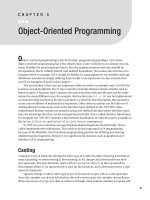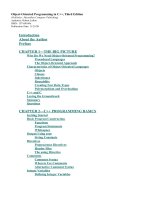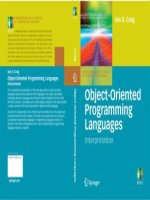Lecture Object oriented programming - Lecture no 01
Bạn đang xem bản rút gọn của tài liệu. Xem và tải ngay bản đầy đủ của tài liệu tại đây (310.15 KB, 39 trang )
CSC241: Object Oriented Programming
Lecture No 01
1
Aim of the course
•
This course provides
–
motivation of object oriented programming language
–
in depth knowledge of the various concepts of object
oriented programming and its implementation in C++
2
Course book
•
Text book
–
•
C++ How to program by Deitel and Deitel
Reference books
–
Waite Group’s Object oriented programming in C++,
Robert Lafore
3
Course outline
Classes, Objects, Member functions, Objects as data types,
Constructors and destructors, Overloaded constructor
The default copy constructor, Returning objects from functions, objects
and memory, Static class data, Constant member functions, Constant
objects
Base classes and derived classes, Derived class constructors,
Overloading member functions, Scope resolution, Abstract classes,
Public and private inheritance, Levels of inheritance, Multiple
inheritance, Aggregation and composition
New and delete operators, Pointers to objects, Virtual functions and late
binding, Abstract classes and pure virtual functions, Virtual destructors,
Virtual base classes, Friend functions and friend classes, Static
functions, this pointer, Dynamic type information
Motivation for exception handling, Try-catch block, Throwing an
exception, Catching multiple exceptions
Streams and files, Templates
4
Marks distribution
•
Assignments:
10%
•
Quizzes:
15%
•
Sessional exam 01:
10%
•
Sessional exam 02:
15%
•
Terminal Exam:
50%
5
Introduction
•
Five concepts in object oriented programming
are:
–
Object
–
Classes
–
Encapsulation
–
Inheritance
–
Polymorphism
6
Simple analogy
•
You are driving a car
•
You can pressing accelerator pedal
•
Someone has design it and built it
•
Engineering drawings car
•
•
Drawings also includes design for accelerator
pedal to make car go faster
We can say, pedal “hides” complex mechanism
that make the car go faster
7
Cont.
•
•
•
Brake pedal “hides” the mechanism that slow the
car
Steering wheel “hides” the mechanism that turn
the car and so on
Simple “interfaces” like accelerator and brake
pedal, steering wheel, transmission shift and etc.
allow driver to interact car’s complex internal
mechanisms
8
Points to be noted
•
•
•
You cannot drive the engineering design of a car
Before you can drive a car, it must be built
according to engineering design
The car will not accelerator on its own, a driver
must press the accelerator pedal
9
Object oriented programming concepts
•
•
•
•
Function hides from user the complex task it
performs
Same as accelerator pedal hides complex
mechanism of making the car go faster
C++ makes a program unit called class that
houses various functions
Same as car engineering design houses the
mechanism of accelerator pedal
10
Cont.
•
•
In C++, a class can have various functions that
are design to perform a class tasks
For example, a class representing bank account
might contain functions
–
Deposit money
–
Withdraw money
–
Current balance
11
Car example
Real world
•
•
Engineering drawing
cannot be drive
A car is build from
that drawing
C++ programming
•
An object of a class
must be create to get
a program to perform
the tasks the class
describes
•
•
Pressing accelerator
pedal sends a
message to car to
Message can be sent
to object by calling a
member functions
12
Cont.
•
•
Car analogy is used to introduce
Class
–
Objects
–
Member functions
In addition to capabilities of car, it has many
attributes
•
•
–
Color, No. of doors, amount of gas in tank,
total miles driven and etc
Attributes are part of car engineering drawing
13
Cont.
•
•
•
•
These attribute are always associated with the
car
Every car maintains its own attribute
Example 1: each car knows how much gas in its
own tank but do not know how much is in the
tanks of other cars
Example 2: a bank account object has a balance
attribute. Each bank account object knows the
balance in its account not the others
14
Object
•
•
•
Look around right now and you'll find many
examples of real-world objects:
your dog, your desk, your television set, your
bicycle.
Real-world objects share two characteristics:
They all have
–
State and
–
Behavior
15
Object example
•
•
A dog x has state (name, color, breed, hungry)
and behavior (barking, fetching, wagging tail).
Your bicycle also have state (current gear,
current pedal cadence, current speed) and
behavior (changing gear, changing pedal
cadence, applying brakes).
16
Cont.
•
For each object that you see, ask yourself two
questions:
–
"What possible states can this object be in?" and
–
"What possible behavior can this object perform?"
17
Real world objects
•
Real-world objects vary in complexity
–
your desktop lamp may have only two
possible states (on and off) and two possible
behaviors (turn on, turn off),
–
but your desktop radio might have additional
states (on, off, current volume, current station)
and behavior (turn on, turn off, increase
volume, decrease volume, seek, scan, and
tune).
18
Cont..
•
•
You may also notice that some objects, in turn,
will also contain other objects.
These real-world observations all translate into
the world of object-oriented programming
19
Class
•
•
•
•
In the real world, you'll often find many individual
objects all of the same kind
There may be thousands of other bicycles in
existence, all of the same make and model.
Each bicycle was built from the same
engineering design and contains the same
components.
In object-oriented terms, we say that your
bicycle is an instance of the class of objects
known as bicycles.
20
Software Object
•
Software objects are conceptually similar to realworld objects: they too consist of state and
related behavior. An object stores its state in
–
fields (variables in some programming languages)
and exposes its behavior through
–
methods (functions in some programming languages).
A Software Object
21
Cont.
•
Methods operate on an object's internal state
and serve as the primary mechanism for objectto-object communication.
22
Class vs. Object
•
Class is a blue print of an object, which is nonlive entity.
•
Object is instance of class, which is a live entity.
•
Example:
–
Employee is a class
–
Fruit is a class
–
I am an object
–
apple is an object
23
Points to remember
•
•
A class is not a living entity, it is just a
engineering design that how an object of this
class look like
Object are living entities
24
Defining a class with member function
25









